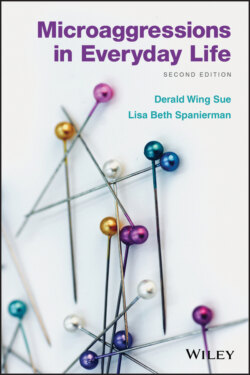Читать книгу Microaggressions in Everyday Life - Derald Wing Sue - Страница 32
Microassaults
ОглавлениеMicroassaults are conscious, deliberate, and either subtle or explicit racial, gender, or sexual‐orientation biased attitudes, beliefs, or behaviors that are communicated to marginalized groups through environmental cues, verbalizations, or behaviors. They are meant to attack the group identity of the person or to hurt/harm the intended victim through name‐calling, avoidant behavior, or purposeful discriminatory actions (Miller & Garran, 2008; Nelson, 2006). Displaying a Klan hood, Nazi swastika, noose, or Confederate flag; burning a cross; and hanging Playboy bunny pictures in a male manager's office may all constitute microassaults that reflect individual expressions of environmental macroaggressions. The intent of these messages oftentimes is to threaten and intimidate. These messages make people feel unwanted and unsafe because they are deemed inferior, subhuman, and lesser beings who do not belong on the same levels as others in this society.
Figure 2.1 Categories of and Associations among Microaggressions. Reproduced with permission of Sue, D. W. et al. (2007).
Verbal microassaults include the use of racial epithets: referring to African Americans as “n*****s,” Chinese Americans as “chinks,” Japanese Americans as “Japs,” Native Americans as “savages,” women as “bitches” or “cunts,” and gay men as “fags.” Again, the intent is to assail people’s racial, social‐group identity and to communicate to recipients that they are lesser human beings. Telling ethnic, racial, gender, or sexual‐orientation jokes and laughing at them also might fall into this category. With respect to behavior, forbidding a son or daughter from marrying outside of one's race, ignoring a group of women who are requesting a table at a restaurant, and promoting a less‐qualified heterosexual employee over a gay one are additional examples of intent to harm or exclude. Again, such actions communicate to recipients that they are unworthy to be served and/or that they are not the right kind of people and do not belong.
Microassaults are most similar to what has been called old‐fashioned racism, sexism, or heterosexism perpetrated on an individual level. They are likely to be conscious and deliberate acts. However, because of strong public condemnation of such behaviors, microassaults are most likely to be expressed under three conditions that afford the perpetrator some form of protection (D. W. Sue & Capodilupo, 2008).
First, when perpetrators feel some degree of anonymity and are assured that their roles or actions can be concealed, they may feel freer to engage in microassaults (scrawling anti‐Semitic graffiti in public restrooms, posting anonymous epithets against Muslims on the web, or hanging a noose surreptitiously on the door of a Black colleague).
Second, consistent with research by Bursztyn et al. (2017), perpetrators may engage in a microassault when they feel relatively safe, such as being in the presence of people who share their beliefs and attitudes or knowing that they can get away with their offensive words and deeds. Safety often relies on the inaction of others in the face of biased actions. In fact, studies reveal that people often overpredict whether they would take action against a biased action (hearing a racist comment). While they may condemn and say they would take appropriate action, when faced with the real situation they remain silent or inactive (Kawakami, Dunn, Karmali, & Dovidio, 2009). Example 2.5 is representative of this condition.
Third, many people who privately hold notions of minority inferiority will display their biased attitudes only when they lose control. The opening examples in this chapter, especially that of Rosanne Barr, demonstrate this third condition of losing control. According to Barr, she was taking a sedative, Ambien, which resulted in her being an “idiot.” It is also possible that she was less controlled on this sedative and thus she was unable to censor her racist assumptions.
Microassaults are most similar to “old‐fashioned” racism: They are the type the public generally associates with “true racism”: direct, deliberate, obvious, and explicit. The key to understanding microassaults is that there is no guesswork involved in their intent, which is to harm, humiliate, or degrade people of color, women, and LGBTQ individuals.
